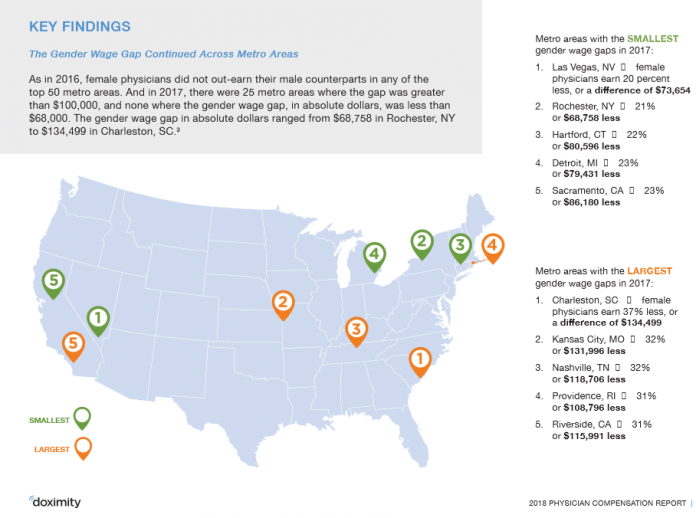
PROVIDENCE – Local female doctors are paid 31 percent less than their male counterparts, ranking fourth among the top five largest gender wage gaps in the country, according to Doximity’s second annual Physician Compensation Report.
Doximity, a network of physicians and advanced practice clinicians based in San Francisco, released the report March 14. It shows Providence female physicians make an average annual salary of $245,986, while female doctors in Milwaukee, Wis., the metro with highest-paid female physicians, make $313,857 annually.
While doctors saw an average 4 percent wage increase nationally from 2016 to 2017, the gender wage gap in Providence increased 6 percent, one of largest increases in the country for that period.
“The gender pay gap is a serious problem for Rhode Island women and their families, especially women of color,” said Georgia Hollister Isman, director of the Rhode Island Working Families Party.
“Each year the average Rhode Island woman loses almost $10,000 to the pay gap. That is money women, their families and their communities need. That is why it is so urgent that we pass the Fair Pay Act this year and why a broad coalition of labor, women’s, domestic violence, anti-poverty and racial-justice groups have come together to support it,” she said.
Emmanuel Falck, spokesman for District 1199 SEIU New England, said the union supports the Fair Pay Act (2018-H 7427), sponsored by Sen. Gayle L. Goldin, D-Bristol, and Rep. Susan R. Donovan, D-Providence, which would make it illegal to pay workers less than their white, male colleagues without a clearly documented difference in skills. The legislation was introduced in January.
Doximity surveyed more than 65,000 licensed U.S. doctors to produce the report, 260 of them in Rhode Island. It details how compensation has changed from 2016 to 2017, evaluating trends across metropolitan areas, medical specialties and gender.
“Our hope is these findings contribute to a better understanding of why some areas may see more severe physician shortages than others,” the report states in its introduction, also noting a looming shortage of physicians in America. By 2030, the country could see a shortage of more than 100,000 doctors, according to a report from the Association of American Medical Colleges.
The gender pay gap continued throughout medical specialties, with women doctors making 14-20 percent less than their male colleagues in hematology, occupational medicine, urology, orthopedic surgery, gastroenterology, colon and rectal surgery, pediatric infectious disease, pediatric cardiology, geriatrics and plastic surgery.
As with the 2016 findings, there are no medical specialties in which female doctors earned more than male doctors. Also, women earn less than men in all of the top 50 metro areas, according to the report.
“All health care stakeholders should be aware of the differences in compensation for men and women across the country,” said Dr. Christopher Whaley, the report’s lead author and adjunct assistant professor at the University of California Berkeley School of Public Health. “Compensation inequity can directly affect where and what physicians choose to practice, which could ultimately affect patient access.”
Rob Borkowski is a PBN staff writer. Email him at Borkowski@PBN.com.












